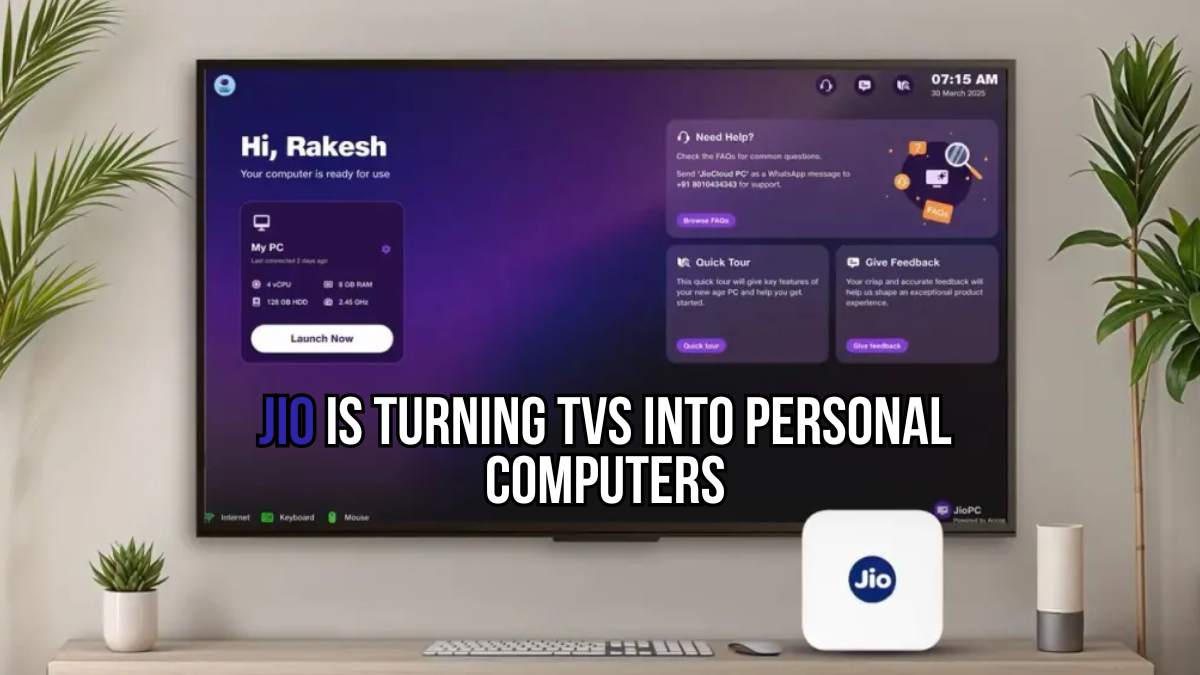Reliance Jio has launched something that could completely change how millions of Indians access computing. JioPC, a virtual desktop service that transforms any television into a fully functional personal computer, represents a bold move to bridge India’s digital divide.
The service works through Jio’s set-top box, requiring only a keyboard and mouse to turn your TV into a cloud-based PC. Currently available as a free trial through a waitlist system, JioPC aims to bring affordable computing to households across India particularly in regions where PC ownership remains limited.

This innovation couldn’t come at a better time. While 70% of Indian households own a TV, only about 15% have a personal computer. JioPC has the potential to unlock computing access for millions of families who never considered owning a traditional PC.
What is JioPC and How Does It Work?
JioPC is a cloud-based virtual desktop service that runs entirely through Jio’s set-top box. The concept is brilliantly simple: instead of buying an expensive computer, users can access a full desktop experience through their existing television.
The setup process is straightforward. Users need a Jio set-top box, which comes free with JioFiber broadband plans or can be purchased separately for Rs 5,499 ($64). Once connected, you simply plug in a keyboard and mouse to access the virtual desktop.
The service operates entirely in the cloud, meaning the actual computing happens on Jio’s servers rather than on local hardware. This approach eliminates the need for expensive processors, hard drives, or memory modules in users’ homes.
Currently, JioPC is in a free trial phase and available only through invitations. Users must join a waitlist to gain access, suggesting Jio is carefully managing the rollout to ensure system stability and user experience.
Key Features and Current Limitations
JioPC comes with several essential applications pre-installed, including LibreOffice, an open-source alternative to Microsoft Office. This means users can immediately start working with documents, spreadsheets, and presentations without additional software purchases.
For those who prefer Microsoft Office applications, the service allows access through its built-in browser. While this isn’t as seamless as having native apps, it provides flexibility for users who rely on specific Microsoft features.
The service handles basic computing tasks effectively. Users can browse the web, attend online classes, work on documents, and perform typical desktop activities. The cloud-based nature ensures that files and settings are preserved between sessions.
However, JioPC has notable limitations in its current form. The service doesn’t support external peripherals like cameras or printers, which could limit its usefulness for certain tasks. This restriction may affect users who need to scan documents, print materials, or participate in video calls requiring external cameras.
The lack of peripheral support also means businesses or educational institutions looking to implement JioPC may need to find workarounds for common office tasks like printing or document scanning.
The Market Opportunity in India
The timing for JioPC couldn’t be more strategic. India’s PC market grew over 8% in Q1 2025, reaching 3.3 million units, but this growth still leaves the country far behind nations like the US and China in terms of PC ownership per capita.
Several factors contribute to India’s low PC penetration rates. High device costs remain a significant barrier, with quality computers often costing more than many families can afford. Additionally, smartphones have become the primary computing device for many Indians, reducing the perceived need for traditional PCs.
According to government data, India has approximately 57 million active set-top box users. This existing infrastructure provides JioPC with a massive potential user base that already has the necessary hardware to access the service.
Tarun Pathak from Counterpoint Research notes that JioPC represents “a very effective way” for Jio to expand its user base, which already exceeds 488 million subscribers. The service could be particularly appealing to families who have avoided purchasing computers due to cost concerns.
Potential Impact on Digital Inclusion
JioPC could significantly advance digital inclusion efforts across India. Many households, particularly in rural areas, have been excluded from the digital economy due to the high cost of computing devices. By leveraging existing TV infrastructure, JioPC removes a major barrier to computer access.
The service could prove especially valuable for education. Students in households without computers have struggled with online learning, particularly during the pandemic. JioPC could provide these students with access to educational resources, online classes, and digital learning tools.
For small businesses and entrepreneurs, JioPC offers an affordable way to access productivity tools and online services. Business owners could use the service for inventory management, customer communication, and basic accounting tasks without investing in expensive hardware.
The potential for AI integration adds another dimension to JioPC’s value proposition. Future updates could include smart document tools, virtual learning applications, and AI-powered productivity features that make the service even more compelling.
Technical Considerations and Challenges
The success of JioPC depends heavily on internet connectivity and server infrastructure. Since all computing happens in the cloud, users need reliable, high-speed internet connections to ensure smooth performance. This requirement could limit the service’s effectiveness in areas with poor connectivity.
Latency issues could also affect user experience, particularly for tasks requiring real-time interaction. While basic productivity tasks may work well, more demanding applications might suffer from delays between user input and system response.
Jio’s server capacity will be crucial as the service scales. The company must ensure adequate computing resources to handle growing user demand while maintaining performance standards.
Digital literacy presents another challenge. Many potential users may not be familiar with cloud computing concepts or may need guidance on using desktop interfaces. Jio will need to invest in user education and support to maximize adoption.
The Road Ahead
For JioPC to realize its full potential, strategic partnerships will be essential. Collaboration with app developers and productivity tool providers could expand the service’s capabilities and make it more attractive to diverse user groups.
Educational partnerships could help integrate JioPC into school systems, providing students with access to computing resources regardless of their family’s economic situation. Government initiatives supporting digital literacy could also boost adoption rates.
The service’s future success will depend on how effectively Jio addresses current limitations. Adding support for external peripherals, expanding app availability, and improving performance will be crucial for long-term viability.
Prabhu Ram from CyberMedia Research believes JioPC could particularly succeed in underserved regions, but notes that success will depend on execution especially in addressing connectivity gaps and digital literacy challenges.
Transforming India’s Digital Landscape
JioPC represents more than just a new product launch; it’s a potential catalyst for digital transformation across India. By making computing accessible to households that previously couldn’t afford it, the service could accelerate digital adoption and create new opportunities for education, business, and innovation.
The service’s success will ultimately depend on user adoption, performance reliability, and Jio’s ability to expand capabilities over time. If executed well, JioPC could become a model for bringing affordable computing to emerging markets worldwide.
For millions of Indian families, JioPC might be their first real introduction to personal computing. The implications of this democratization of technology access could reshape how an entire generation learns, works, and participates in the digital economy.
FAQs
1. What is JioPC?
A. JioPC is a virtual desktop service launched by Jio that enables users to transform their existing televisions into fully functional personal computers using cloud technology.
2. How does JioPC work?
A. JioPC utilizes a small device or dongle that connects to the television. This, combined with cloud-based infrastructure, provides users access to computing capabilities directly from their TV screens.
3. What are the benefits of using JioPC?
A. JioPC offers affordability, ease of access, and convenience for users, especially in regions where traditional computers may be cost-prohibitive. It helps promote digitization, learning, and productivity through a readily available platform.
4. Who is JioPC designed for?
A. JioPC is aimed at families, students, small business owners, and others in India who may not have regular access to personal computers but seek affordable, efficient alternatives.
5. What do I need to use JioPC?
A. To use JioPC, you need a compatible television, an active internet connection, and Jio’s hardware or software solution designed to enable the service.
6. Can I use JioPC for work or education?
A. Yes, JioPC is designed to support basic work and educational needs. It offers access to productivity tools, internet browsing, and cloud-based applications essential for these activities.
7. Is JioPC available everywhere in India?
A. JioPC aims to reach every corner of India. The availability depends on the rollout of services by Jio in specific areas and the accessibility of the necessary infrastructure.
8. How affordable is JioPC?
A. JioPC offers an affordable alternative to traditional computing. Pricing details may vary, but Jio strives to make the service cost-effective for Indian households.
For More Information Click HERE










